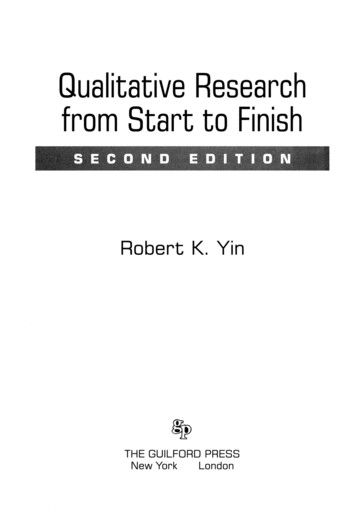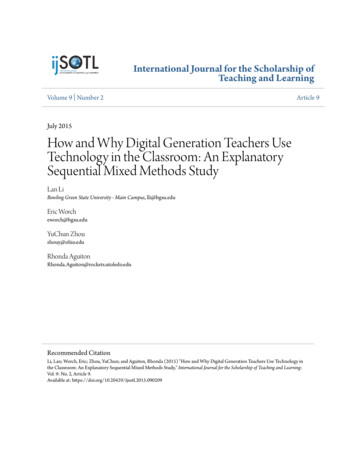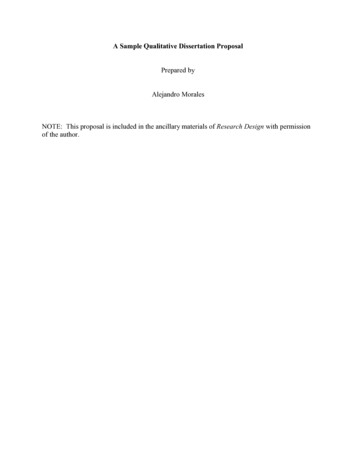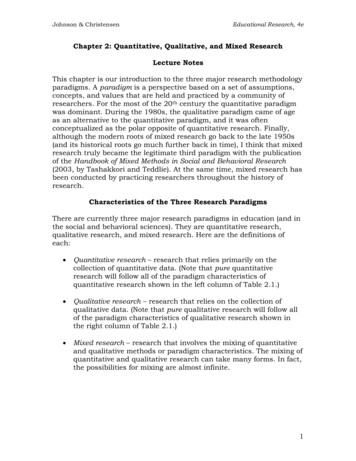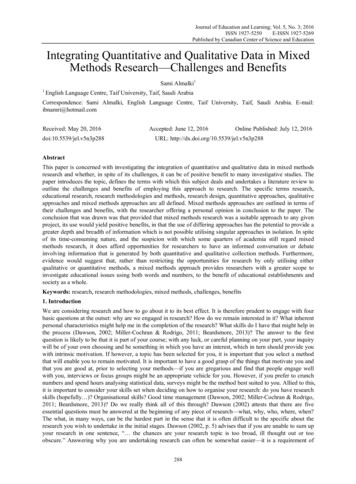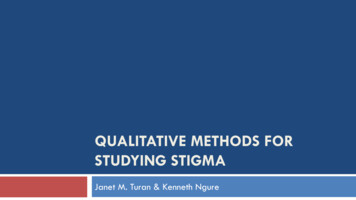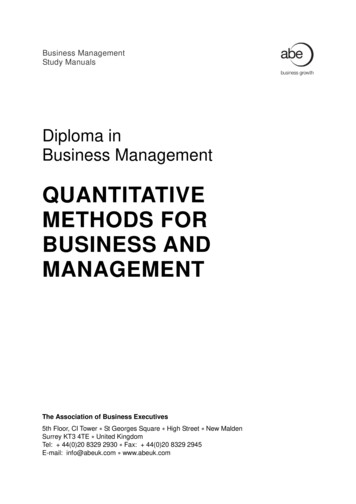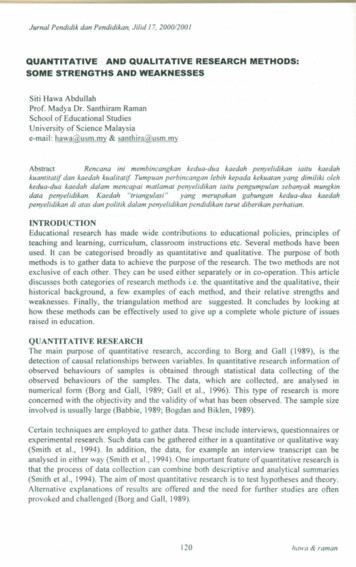
Transcription
Jurnal Pendidik dan Pendidikan, Jilid 17, 200012001QUANTITATIVEAND QUALITATIVERESEARCH METHODS:SOME STRENGTHS AND WEAKNESSESSiti Hawa AbdullahProf. Madya Or. Santhiram RamanSchool of Educational StudiesUniversity of Science Malaysiae-mail: hawa@usm.my&santhira@usm.myAbstractRencana ini membincangkankedua-dua kaedah penyelidikaniaitu kaedahkuantitatif dan kaedah kualitatif Tumpuan perbincangan lebih kepada kekuatan yang dimiliki olehkedua-dua kaedah dalam mencapai matlamat penyelidikan iaitu pengumpulan sebanyak mungkindata penyelidikan.Kaedah"triangulasi"yang merupakan gabungan kedua-dua kaedahpenyelidikan di atas dan politik dalam penyelidikan pendidikan turut diberikan perhatian.INTRODUCTIONEducational research has made wide contributions to educational policies, principles ofteaching and learning, curriculum, classroom instructions etc. Several methods have beenused. It can be categorised broadly as quantitative and qualitative. The 'purpose of bothmethods is to gather data to achieve the purpose of the research. The two methods are notexclusive of each other. They can be used either separately or in co-operation. This articlediscusses both categories of research methods i.e. the quantitative and the qualitative, theirhistorical background, a few examples of each method, and their relative strengths andweaknesses. Finally, the triangulation method are suggested. It concludes by looking athow these methods can be effectively used to give up a complete whole picture of issuesraised in education.QUANTIT ATIVE RESEARCHThe main purpose of quantitative research, according to Borg and Gall (1989), is thedetection of causal relationships between variables. In quantitative research information ofobserved behaviours of samples is obtained through statistical data collecting of theobserved behaviours of the samples. The data, which are collected, are analysed innumerical form (Borg and Gall, 1989; Gall et aI., 1996). This type of research is moreconcerned with the objectivity and the validity of what has been observed. The sample sizeinvolved is usually large (Babbie, 1989; Bogdan and Biklen, 1989).Certain techniques are employed to gather data. These include interviews, questionnaires orexperimental research. Such data can be gathered either in a quantitative or qualitative way(Smith et aI., 1994). In addition, the data, for example an interview transcript can beanalysed in either way (Smith et aI., 1994). One important feature of quantitative research isthat the process of data collection can combine both descriptive and analytical summaries(Smith et aI., 1994). The aim of most quantitative research is to test hypotheses and theory.Alternative explanations of results are offered and the need for further studies are oftenprovoked and challenged (Borg and Gall, 1989).120hawa & raman
Jurnai Pendidik dan Pendidikan, Jilid J 7, 20001200 JGenerally, quantitative research involves systematic measurement, experimental and quasiexperimental methods, statistical analysis and mathematical models (Linn, 1986, p.92).Quantitative research is structured, logical, measured and carried out on a wider scale thanqualitative research which is more intuitive, subjective and carried out in a more intensemanner on fewer subjects. Therefore, as Bouma and Atkinson (1995, p. 208) state: "Somesubjects are best investigated using the quantitative approach whilst for others, qualitativeapproaches will give better results. However in some cases both methods can be used."Survey MethodThe survey method is the most frequently used type of self-research report (Gay, 1987). Itprovides an opportunity for the researcher to collect data from a population in order todetermine the current status of that population with respect to one or more variables. It hasbeen used in many fields such as in political science, education and economics.The survey method is a constructive research methodology and can be considered as asystematic data collection tool used in large scale investigations (Borg and Gall, 1989;Smith et aI., 1994). Survey instruments include questionnaires and the individual interview.Information collected by such methods are often quantifiable (Borg and Gall, 1989). Inconducting a survey, several tools can be used either alone, in combination or triangulation.The most common tools used in survey research are the mailed questionnaire, face-to-faceinterview, and telephone interview (Gay, 1987). Other methods that can be used to collectsurvey information include the records of examinations.Whatever tools are used, the main purpose of survey research is to obtain standardinformation from all subjects in the sample in order to generalise the findings (Gall et aI.,1996).type of survey and data analysisThere are two types of survey out Iined by Borg and Gall (1989). They are the crosssectional survey and the longitudinal survey. In the cross-sectional survey data are collectedfrom a sample from a predetermined population (Borg and Gall, 1989). The information iscollected at one point in time although the actual time required to complete may take morethan a day or a month. Generally, it can be analysed in two ways, i.e. descriptions of singlevariables and exploration of relationships.In the description of single variables, the data reflect the result of the total sampledistributed which may include many alternative responses in a single questionnaire. In thesecond type, the survey is used to explore relationships between two or more variables(Borg and Gall, 1989). Questionnaire items may refer to past, present and futurephenomena.In the longitudinal survey, data are collected at different points in time (Borg and Gall,1989). The purpose of this is to enable changes or time-ordered associations to be studied.While the cross-sectional study is limited by time factors, the longitudinal survey is not. Asa result, the data are not distorted by faulty recollection of the respondents (Borg and Gall,1989).121hawa & raman
Jurnal Pendidik dan Pendidikan, Jilid 17, 200012001questionnaireMost data in quantitative research can be obtained by the questionnaire (Smith et aI., 1994).The questionnaire is often used large scale surveys as it requires less time and is lessexpensive (Gay, 1987). Although questionnaires are usually mailed, they can also bepersonally administered.In designing a questionnaire the first step is to define the problem and list the specificobjectives to be achieved or hypotheses to be tested by the questionnaire. It is important tobear in mind the methods of data analysis that will be used in analysing the returnedquestionnaires designing the questionnaire (Borg and Gall, 1989).The second step is identifying the sample. It is important that appropriate subjects who havethe information and who are willing to give the information be included (Borg and Gall,1989). However, there are some cases where the questionnaires need to be sent to groupswho do not have the desired information, but most questionnaire studies conducted ineducation are aimed at specific professional groups or authorities (Borg and Gall, 1989).The advantages of the questionnaire especially the rnailed questionnaire.Tsit's lower costand the speed of dissemination and collection (Gay, 1987; Borg and Gall, 1989). It can alsocover a very much wider geographic area compared to other tools such as the interview orexperimental research. In fact, the personally administered questionnaire has the sameadvantages as the use of an interview. It enables the establishment of a good rapport withrespondents, to explain the purpose of study and to clarify items (Gay, 1987). It allows alarge number of subjects to be sampled. It only requires the subjects to be literate andunderstand the questions (Kathwohl, 1993). The questionnaire has been widely used inquantitative research because its standardised, highly structured design is compatible withthe quantitative approach. They are simple to use and analyse but on the other hand, thedesign is by no means simple. The main decisions to be made when designing aquestionnaire are the type of questions to be included and the overall format of thequestionnaire.The questionnaire, however, does not allow respondents' opirnon and feelings to beexpressed freely. Another disadvantage is that once the questionnaires have been distributedit is impossible to modify the items, even though they may be unclear to some respondents(Oppenheim, 1992; Borg and Gall, 1989). Any ambiguities cannot then be clarified.Therefore, items should be carefully paraphrased and partitioned so that the response isdefinite and no confusion as to meaning of response is possible.A serious problem in questionnaire is non response (Krathwohl, 1993). Since it involves alarge sample who are usually volunteers, the researcher has no power to force them toreturn the questionnaire even though self-addressed envelopes with stamps affixed are used.Sometimes the return may be delayed (Bryman, 1989).QUALITATIVE RESEARCHThe qualitative research model was developed primarily in social science research. Itinvolves a particular philosophy and a strategy to boot. This type of research embracesnaturalistic, ethnographic, participant observational, case studies and, subjective or122hawa & raman
Jurnal Pendidik dan Pendidikan, Jilid 17, 200012001POStPOSltlVIStstudies. Although each possesses a slightly different approach, they aresimilar in certain respects although varying from user to user and from time to time(Bogdan and Biklen, 1982; Borg and Gall, 1989). According to Denzin and Lincoln (1994)qualitative research is "multimethod in its focus involving an interpretative, naturalisticapproach to its subject matter. This means that the qualitative researcher studies things intheir natural settings, attempting to make sense of, or interpret, phenomena in terms of themeaning people bring to them." (Denzin and Lincoln, 1994, p. 2). Maanen (1983) in Borgand Gall (1989), defined the qualitative method as "an array of interpretative techniqueswhich seek to describe, decode, translate and otherwise come to terms with the meaning,not the frequency, of certain more or less naturally occurring phenomena in the socialworld" (Maanen, 1983, p. 9).A qualitative researcher is a "first informer' (Bogdan and Binklen, 1982) who obtainsinformation by collecting primarily verbal data by means of intensive case studies and thenanalyses the data. This is one reason why qualitative research is much more difficult toundertake because the researcher himself/herself is the main tool for collecting data (Borgand Gall, 1989).Qualitative researchers also avoid going into a study to test specific questions or hypotheses(Bogdan and Binklen, 1982; Borg and Gall, 1989). Instead, they believe that finding theanswers to questions should be one of the products of data collection rather than setting outto prove an assumption. The research can be structured through the study itself not throughthe presentation of any preconceived ideas or precise research design.Because qualitative researchers are themselves a primary instrument in data collection, theyrely partly or entirely on their feelings, impressions and judgement in data collecting (Borgand Gall, 1989; Bogdan and Binklen, 1982). They also rely heavily on their owninterpretations iri understanding the meaning of their data. Findings are often reported in theform of verbal descriptions rather than in the form of quantitative summaries as in statisticalanalysis.This type of research, according to Borg and GaIT (1989), promotes close interaction withthe respondents. The data arising out of these interactions is in the form of what peoplereveal to the researcher and the researcher's impressions. Such "collaborative inquiry"labelled by Torbert (1981) can improve the validity and usefulness of the findings. This isbecause most of the phenomena that interest the researchers are internal events such asperceptions and feelings rather than overt behaviour.Qualitative researchers based their research on the assumption that the social environmentis transitory (Borg and Gall, 1989). They therefore develop knowledge by collectingprimary verbal data through intensive cases studies and subjecting these data to analyticalinductions.Qualitative researchers use the natural setting as a direct source of data of which they arethe key instruments (Borgdan and Binklen, 1982). They will go to the particular setting toassess the context, because they believe and assume that the setting influences humanbehaviour in which it occurs and has therefore to be observed.123hawa & ram an
Jurnal Pendidik dan Pendidikan, Jilid 17,200012001Results are presented in a descriptive way (Bogdan and Biklen, 1982). These may be in theform of quotations to illustrate and support the presentation, for instance, interviewtranscripts, field notes, videotapes, personal document etc. All the findings will be analysedas close as possible to the form from which it was recorded or transcribed. Althougheverything is seen as a useful aid to a comprehensive assessment (Borgdan and Binklen,1982) only a small amount of data will eventually be used. What is finally presented in theresearch report is "barely the tip of the iceberg in that field and transcript extracts arechosen as being representative and illustrative of action that was frequently observed"(Salisbury, 1986, p. 23).In qualitative research emphasis is placed on the process (Bogdan and Binklen, 1982) andno hypothesis is made and tested. Strategies employed suggest how the expectations aretranslated into daily activities and are activated to discover why and how such situationsoccur.Qualitative researchers are more likely to study the individual case (Borg and Gall, 1989)because each individual, class, culture or society is likely to have an idiosyncratic set ofvalue, feelings and beliefs that can only be discovered through intensive study of thatindividual, school or class.According to Bouma and Atkinson (1995) the essence of qualitative research is to viewevents through the perspective of the people who are being studied; the way they think, andtheir view of the world etc. Qualitative research requires the researcher to empathise withthe people being studied.Therefore qualitative research necessarily includes a longitudinal element as the subjects ofthe study are studied over a period of time and the emphasis is on the process of how thingshappen and change. Qualitative researchers typically provide detailed descriptions of thesettings they investigate (Bogdan and Binklen, 1982).This type of research is relatively unstructured. Because it is so open ended, the investigatoroften does not decide in advance precisely what is to be investigated. This open approachallows the researcher to investigate unexpected topic which may only become apparentafter an investigation has begun. Qual itative researchers often reject the formulation oftheories until after they have started the investigation.In summary, qualitative research refers to any social science study that produces results thatare not obtained by statistical procedures or other methods of quantification. Althoughsome of the data may be quantified, the analysis is generally qualitative. It can refer toresearch regarding people's lives, their stories, and behaviour and it can also be used toexamine organisations, relationships and social movements. Research done in this wayproduces descriptive data such as people's own spoken or written words or observablebehaviour. The methods used by qualitative researchers include: participant observation,unstructured interviews, life histories . Ethnographic MethodOne research method, which has been classified as qualitative research, is ethnography.Ethnographic methods of research have been introduced and used extensively by124hawa & raman
Jurnal Pendidik dan Pendidikan, Jilid J 7, 20001200 Ianthropologists for many years. Although it is a new method in the educational field, theimportance of this method has attracted many educational researchers. It provides an indepth and analytical description of an intact culture scene (Borg and Gall, 1989).In this method the researcher tries to immerse one self in a setting and to become part of thegroup, in order to understand the meanings and significance that people put upon theirbehaviour and that of others (Smith et aI., 1994). Everything that happens in the setting willbe observed continuously and researchers will try their best to record it virtually as it exists.Data will be collected from many variables over an extended period of time. According toGay (1987), the variables being investigated are studied where they naturally occur, and arenot under any environmental control of the researcher.In education, the setting is usually on a small scale such as in a classroom or even a school.The reason for this is that the educational organisation has a very large influence on thebehaviour of the people in it such as pupils, teachers and headmasters/headmistresses.Theethnographer works by observing many aspects of the learning environment to identifyfactors associated with effective and/or ineffective environments (Fienberg, 1979).Ethnography is a method of research based on the belief that behaviour is significantlyinfluenced by the environment in which it occurs. " .if we wish to generalise our findingsto real-world settings, the findings should be derived from research conducted in a realworld setting" (Gay, 1987, p. 121 ).To conduct the study, the ethnographer first plans the research studies, defines and refinesthe research problem, which interests them, and finds the most appropriate environment orsetting of study and effective level of participant. Their purpose is not to test anyhypothesis. Attempts will be made to derive specific, testable hypotheses that explain theobserved behaviour (Gay, 1987; Borg and Gall, 1989; Gall et aI., 1996).Participant observation, and/or non-participant observation can be used in this type ofresearch (Gay, 1987; Borg and Gall, 1989). According to Gay (1987), ethnographic studiesare characterised by some kind of participant observation at an overt level. In collecting thedata, the ethnographer uses a variety of strategies in conjunction with observation, bothverbal and non-verbal (Pelto and Pelto, 1978). Verbal strategies include the interview, bothstructured and unstructured, in which there is interaction between researcher and subjects inorder to get the necessary data. Non-verbal strategies, include for instance, tape recorders,field notes, and diaries which according to Gay (1987), are less obstructive and less likelyto affect the behaviour being studied.Participant ObservationThis is one of the main techniques used in ethnographical research (Skager and Weirberg,1971). In this type of research the researcher's investigations are flexible and the details ofthe approach are often modified as the research proceeds. According to Robson (1995) thereason for this is that the researcher who starts the investigation with a specific hypothesismay impart misconceptions into the setting. However, the participants define the setting andtheir view cannot be known unti I the investigation begins (Bogdan and Biklen, 1983;Walker, 1985; Gay, 1987). The observer becomes a part of the field in which the subjectsare observed so that they can provide a view from the inside because the view from within125hawa & raman
Jurnai Pendidik dan Pendidikan, Jilid 17,200012001may be very different from the view from with out (Gay, 1987; Bouma and Atkinson,1995).The role of the observer is not easy. There are certain degrees of participant observationdepending on the purpose of the study. Observation may be covert and overt (Gay, 1987;Smith et aI., 1994).The overt situation, according to Gay (1987), is one where the observeris present and permission of the subject is sought. In contrast, the covert observation iswhere the subjects do not know the researcher's presence. In this situation, the degree ofparticipant involvement is greater.Researchers who want to use this kind of research have to be well prepared and well trainedbefore starting the investigation (Gay, 1987). Much reading and knowledge is needed as apreparation in order to be able to perceive and respond to the events discovered in theinvestigations. In choosing the site of study, Bouma and Atkinson (1995) suggested that ifthere is a choice, researchers should choose a site where the subjects are strangers becauseknowing beforehand the people to be investigated can influence their behaviour andresponse. It is better to investigate a setting where the researcher has no particular expertisebecause then there is an unbiased intention to evaluate the individual, service orperformance rather than to seek to understand and describe what is happening (Bouma andAtkinson, 1995).Participant observation especially covert observation may provide valid findings and usefuldata (Gay, 1987) as it provides an accurate measurement and assessment of immediateexperience in terms of settings and events happening or occurring.According to Robson (1995) participant observation is the most appropriate technique forgaining access to real life situations. Furthermore, it has a lack of artificiality compared toother techniques and a high potential for providing insight (Gay, 1987). The possibility ofobtaining good reliability and validity is higher especially in formal observations (Robson1995).The length of time spends in the observations helps to establish a more intimate andinformal relationship between the observer and the informant (Cohen and Manion, 1989).The more the time spent, the more data can be gathered and more information gained. Thebehaviour of the participant will be its usual normal self.Some researchers have questioned the validity of information and data obtained in this way(Skager and Weinberg, 1971; Gay, 1987). Participant observation has often been criticisedas being subjective, biased, impressionistic,idiosyncratic and lacking quantifiablemeasurement (Cohen and Manion, 1989). Observing people, especially without theirknowledge requires ethical standard of behaviour especially when recording their wordsand behaviour (Gay, 1987; Borg and Gall, 1989; Robson, 1995). The setting and behaviourof the participant may also affect by the presence of the observer (Borg and Gall, 1989).The greater the observer's participation the greater the observation may be biased (Gay,1987; Robson, 1995).The observation method is also more time consuming when compared to other methods ofdata collecting (Borg and Gall, 1989; Gall et al., 1996). More time has to spent in the fieldto get the information from informants and all the activities and behaviour occurring have126hawa & raman
Jurnai Pendidik dan Pendidikan, Jilid 17, 200012001to be recorded. Time also has to be spent in analysing the data (Borgdan and Binklen,1982).When people are used as an instrument, allowance must be made for some bias (Cohen andManion, 1989; Robson, 1995). Attention may be given to some aspects of the surroundingsrather than others. Personal factors such as interest, experiences, expectations, knowledgeetc. may influence the observation. The possibility of becoming emotionally involved withthe study and the group members is higher in participant observation (Skager andWeinberg, 1971). This can detract from the objectivity of the study.Non Participant ObservationIn this kind of observation the researcher is not directly involved in the situation to beobserved (Gay, 1987; Borg and Gall, 1989). The observer looks in from the outside anddoes not interact with the subjects. Gay (1987) divided this kind of observation into:naturalistic observationand simulation observation.One example of naturalisticobservation, is that used by Piaget in his study of cognitive development in children. In hisstudy, certain kinds of behaviour development regarding cognitive theory were observedwithout any control or interference with the subjects. Normal behaviour, which occurredduring the observation, was studied and recorded. Other examples of natural observationincluded pupils' behaviour at the canteen during recess time and teachers' behaviour duringmeetings, etc.Cohen and Manion (1989) suggested that the best way to be a non-participant observer wasto sit at the back of the classroom and record things as they occur. But the presence of theobserver often changes the situation being observed (Gall et aI., 1996). Furthermore,observational data might only be partly observed due to absence or distraction on the part ofthe observer (Gall et aI., 1996). Although reliability and validity are high it might lose itscomplexity and completeness because it is hard for the informants to give accurateinformation and act in the same manner all the time (Robson, 1995).In some cases it is hard to be objective especially if the observer already has pre knowledgeof the informants' way of life (Robson, 1995). Although trust can be easily developed withthe informants, there may be difficulties in gaining respect from other members of thegroup when confronted with an observer's role. Consequently behaviours and actions maybecome artificial and hesitant. In the educational setting such as schools where thehierarchical structure is vital, a more senior member of staff mar resent being observed orquestioned by a more junior member (Robson, 1995).InterviewThe interview is a commonly used technique in quantitative and qualitative research. It isused to gather data and to develop hypotheses through communication (Cohen and Manion,1989). Cannell and Khan (1968) defined the research interview as 'a two-personconversation initiated by the interviewer for the specific purpose of gaining relevantinformation. It focuses on the content specified by the research objectives and a directverbal interaction between the researcher and the informant. It is an oral exchange betweenindividuals and a response may be limited in a single word or it may require a lengthy oraldiscussion.127hawa& raman
Jurnai Pendidik dan Pendidikan, Jilid 17,200012001Cohen and Manion (1987) outlined three purposes of the interview. First, the interviewenables the respondents to express themselves their feelings, likes and dislikes, and theirbelief. The second purpose of the research interview is to test the hypotheses of new ideasput forward by the researcher and to identify variables and relationships betWeen them.Finally, the interview may be used together with other research methods as a follow-up tounexpected results, to test the validity of other methods or to go deeper into the motivationof respondents and their reasons for acting as they do (Kerlinger, 1970).IAccording to Cohen and Manion (1987) the four kinds of interview used specifically asresearch tools are: the structured interview, the unstructured interview; the non-directiveinterview and the focused interview. For the purpose of educational research usually onlythe first two are used. The structured interview is one in which the content and proceduresare already organised, and the sequence planned. The wordings of the questions aredetermined by means of schedule, and the interviewer has little freedom to makemodifications (Cohen and Manion, 1987). The structured interview involves a series ofclosed-form questions and there are no follow-ups to the answers to obtain greater depth.In contrast, the unstructured interview is more open allowing both researcher and subjectgreater flexibility and freedom although the researcher has control over the researchpurpose, the question, content sequence and wording (Kerlinger, 1970). This type ofinterview is more casual but planned. The purpose is to establish a good rapport betweenthe informant and the interviewer following a structured format. In the semi-structuredinterview, the researcher as an interviewer asks carefully worded questions and probes moredeeply using open- form questions. The purpose is to obtain more in-depth information.Finally, unstructured interview does not involve any detailed guideline. Questions are askedwhich lead the respondents to give the desired information. It is highly subjective and timeconsuming (Borg and Gall, 1989).Different types of interviews are used depending on the purpose and interest of theresearcher. Three major types of interview that have been developed for a particularpurpose and context of research are: key informant interviews, survey interviews and groupinterviews (Borg et aI., 1996).Survey interviews are used to supplement data that have been collected by other methods ofresearch. Goetz and LeCoupte (1984) described three methods of survey interview: theconfirmation survey interview, participant construct interview and project technique. Theconfirmation survey interview is a structured interview, which confirms the earlier findings.It may be useful in large-scale questionnaire studies in which in-depth interviews cannot becarried out because of the large number of respondents or geographical barriers. Theparticipant construct interview is used to gain information regarding the physical structureand social world of the participant. The project technique uses ambiguous stimuli to elicitsubconscious perceptions that cannot be observed in a natural setting (Borg and Gall,1989) . Group interviews involve a group of individuals who have been assembled for the specificpurpose of research, and questions are addressed to them at the same time and place.128hawa& raman
Jurnal Pendidik dan Pendidikan, Jilid 17,200012001The major advantage of the interviews is their adaptability. A skilled interviewer can followup a respondent's answer to obtain more information and clarify vague statements (Borg etaI., 1996). Because subjects can establish rapport and trust with the interviewer, allquestions can be more clearly explained to promote interest an
Jurnai Pendidik dan Pendidikan, Jilid J 7, 20001200 J Generally, quantitative research involves systematic measurement, experimental and quasi-experimental methods, statistical analysis and mathematical models (Linn, 1986, p.92). Quantitative research is structured
